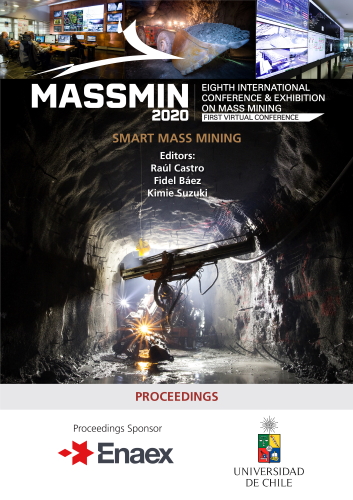Hill of Value financial metrics used to optimise the Carrapateena project

|
Authors: Hocking, RJ; Mooney, AJ; McFadyen, L |
This paper is hosted with the kind permission of Lulea University of Technology, International Conference & Exhibition on Mass Mining, 2024.
DOI https://doi.org/10.36487/ACG_repo/2063_77
Cite As:
Hocking, RJ, Mooney, AJ & McFadyen, L 2020, 'Hill of Value financial metrics used to optimise the Carrapateena project', in R Castro, F Báez & K Suzuki (eds), MassMin 2020: Proceedings of the Eighth International Conference & Exhibition on Mass Mining, University of Chile, Santiago, pp. 1039-1047, https://doi.org/10.36487/ACG_repo/2063_77
Abstract:
Carrapateena is a sub level cave operation located in South Australia. The sub level cave is scheduled to reach a production rate of 4.25 Mtpa by the end of 2020. Hill of Value analysis identified that replacing the lower half of the current sub-level cave with a block cave and expanding the expected annual throughput rate from 4.7–5.0 Mtpa (currently planned from 2023) to 12 Mtpa, has the potential to create significantly more value than the sub-level cave alone. Stage 1 of the Block Cave Expansion Feasibility Study is now underway with completion expected late 2021. The sub level cave to block cave transition presented a unique scenario for optimisation during the scoping study. This paper focuses on optimising the financial performance of the lower block cave using Hill of Value optimisation techniques, taking into account the depletion of the sub level cave at the same time. Various production rates, capital and operating costs, as well as transition timing options were considered within the Hill of Value model. A comparison was performed of how prioritising particular financial investment metrics (Net Present Value (NPV), Internal Rate of Return (IRR), Present Value Ratio (PVR) or Return on Invested Capital (ROIC)), influenced the optimised mine design, rate and schedule. Hill of Value offers the opportunity to optimise the design of the mine at the start of the project, dependent on the goals of the study and broader organisation. This paper shows a thorough method of completing this analysis, while considering the various financial metrics, thereby enabling future studies to consider implications to the mine plan as more information is discovered during the study.
© Copyright 2025, Australian Centre for Geomechanics (ACG), The University of Western Australia. All rights reserved.
View copyright/legal information
Please direct any queries or error reports to repository-acg@uwa.edu.au
View copyright/legal information
Please direct any queries or error reports to repository-acg@uwa.edu.au
